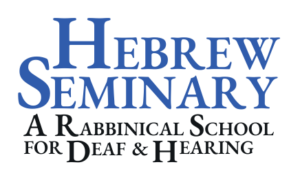Rabbi Jonathan Sacks observed that silence connects the Torah portion B’midbar and the celebration of Shavuot. It is the silence of the desert that counts in Judaism. “Listening is the supreme religious art.” Having said that, Sacks reminds us that in Exodus 24:7, “’All that God says, we will do and we will hear [ve-nishma].’ It is the nishma – listening, hearing, heeding, responding – that is the key religious act.”
Reaching out to Hebrew Seminary supporters, our committee wrote, “At a time in our world when many of us see dark clouds on the horizon, others see recurring rays of hope. For 25 years amidst the flow of changing tides, our seminary has been training rabbinical students to be a Light, come what may.” I am a “recurring rays of hope” kind of person and I believe that we all bring light and a piece of the truth to our listening and responding. On Shavuot, as we reconnect with our religious and spiritual responsibilities it is in the listening that we learn a more open, broader truth. With this truth we strive to “do” immersed in the light of Anochi, the light of the Infinite who continually brings us out of narrow places.
I like Rabbi Zalman Schachter-Shalomi’s, z”l, recognition that the whole world is a teacher:
“Then I come to the B’rakhot [in Birkhot Ha’Shahar, the blessings of the morning] that are the ‘blessings’ of awareness and mind, and I end up giving thanks that sleep has passed from my eyes. I then prepare my mind for learning this day. So I say everything today is going to be a learning experience: Barukh attah Ha’Shem … asher kid’shanu be’mitzvotav ve’tzivanu la’asok be’divrei Torah, or al divrei Torah. ‘Blessed are You … who connects us with holiness by commanding us to engross ourselves in the words of teaching.’ So the whole world is a teacher, and I open myself to it.”
In today’s world our inclination might be to keep quiet and let things play out. Still, if we have done our open listening, prayer and meditation we need to bring our truth to the table. The listening and responding can be religious acts. As my favorite American philosopher Ken Wilber writes, “You were allowed to see the truth under the agreement that you would communicate it to others (that is the ultimate meaning of the bodhisattva vow). And therefore, if you have seen, you simply must speak out. Speak out with compassion, or speak out with angry wisdom, or speak out with skillful means, but speak out you must.” We are all equally responsible for our interwoven future.
Shavuot then is the time to not only stand once again at Sinai to receive from God that which we spiritually know to be true, but to receive truths as they are received by others and to dialogue about those truths. “Our physical pluralism”, says Rabbi Elliot N. Dorff, is matched by an intellectual pluralism for which, the Rabbis say, God is to be blessed: ‘When one sees a crowd of people, he is to say, ‘Blessed is the Master of mysteries,’ for just as their faces are not alike, so are their thoughts not alike.’” Baruch Rab-bee l’sodim.

